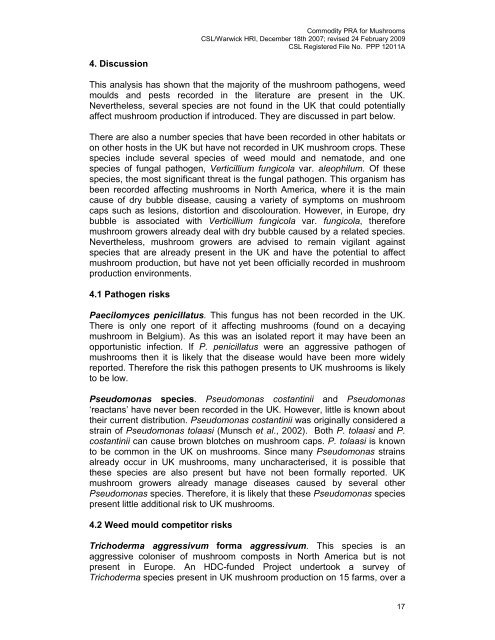Commodity PRA for Agaricus bisporus - Defra
Commodity PRA for Agaricus bisporus - Defra
Commodity PRA for Agaricus bisporus - Defra
Create successful ePaper yourself
Turn your PDF publications into a flip-book with our unique Google optimized e-Paper software.
4. Discussion<br />
<strong>Commodity</strong> <strong>PRA</strong> <strong>for</strong> Mushrooms<br />
CSL/Warwick HRI, December 18th 2007; revised 24 February 2009<br />
CSL Registered File No. PPP 12011A<br />
This analysis has shown that the majority of the mushroom pathogens, weed<br />
moulds and pests recorded in the literature are present in the UK.<br />
Nevertheless, several species are not found in the UK that could potentially<br />
affect mushroom production if introduced. They are discussed in part below.<br />
There are also a number species that have been recorded in other habitats or<br />
on other hosts in the UK but have not recorded in UK mushroom crops. These<br />
species include several species of weed mould and nematode, and one<br />
species of fungal pathogen, Verticillium fungicola var. aleophilum. Of these<br />
species, the most significant threat is the fungal pathogen. This organism has<br />
been recorded affecting mushrooms in North America, where it is the main<br />
cause of dry bubble disease, causing a variety of symptoms on mushroom<br />
caps such as lesions, distortion and discolouration. However, in Europe, dry<br />
bubble is associated with Verticillium fungicola var. fungicola, there<strong>for</strong>e<br />
mushroom growers already deal with dry bubble caused by a related species.<br />
Nevertheless, mushroom growers are advised to remain vigilant against<br />
species that are already present in the UK and have the potential to affect<br />
mushroom production, but have not yet been officially recorded in mushroom<br />
production environments.<br />
4.1 Pathogen risks<br />
Paecilomyces penicillatus. This fungus has not been recorded in the UK.<br />
There is only one report of it affecting mushrooms (found on a decaying<br />
mushroom in Belgium). As this was an isolated report it may have been an<br />
opportunistic infection. If P. penicillatus were an aggressive pathogen of<br />
mushrooms then it is likely that the disease would have been more widely<br />
reported. There<strong>for</strong>e the risk this pathogen presents to UK mushrooms is likely<br />
to be low.<br />
Pseudomonas species. Pseudomonas costantinii and Pseudomonas<br />
‘reactans’ have never been recorded in the UK. However, little is known about<br />
their current distribution. Pseudomonas costantinii was originally considered a<br />
strain of Pseudomonas tolaasi (Munsch et al., 2002). Both P. tolaasi and P.<br />
costantinii can cause brown blotches on mushroom caps. P. tolaasi is known<br />
to be common in the UK on mushrooms. Since many Pseudomonas strains<br />
already occur in UK mushrooms, many uncharacterised, it is possible that<br />
these species are also present but have not been <strong>for</strong>mally reported. UK<br />
mushroom growers already manage diseases caused by several other<br />
Pseudomonas species. There<strong>for</strong>e, it is likely that these Pseudomonas species<br />
present little additional risk to UK mushrooms.<br />
4.2 Weed mould competitor risks<br />
Trichoderma aggressivum <strong>for</strong>ma aggressivum. This species is an<br />
aggressive coloniser of mushroom composts in North America but is not<br />
present in Europe. An HDC-funded Project undertook a survey of<br />
Trichoderma species present in UK mushroom production on 15 farms, over a<br />
17

















